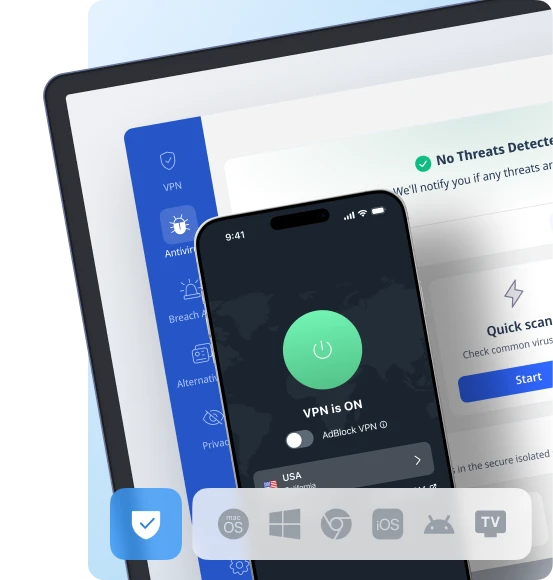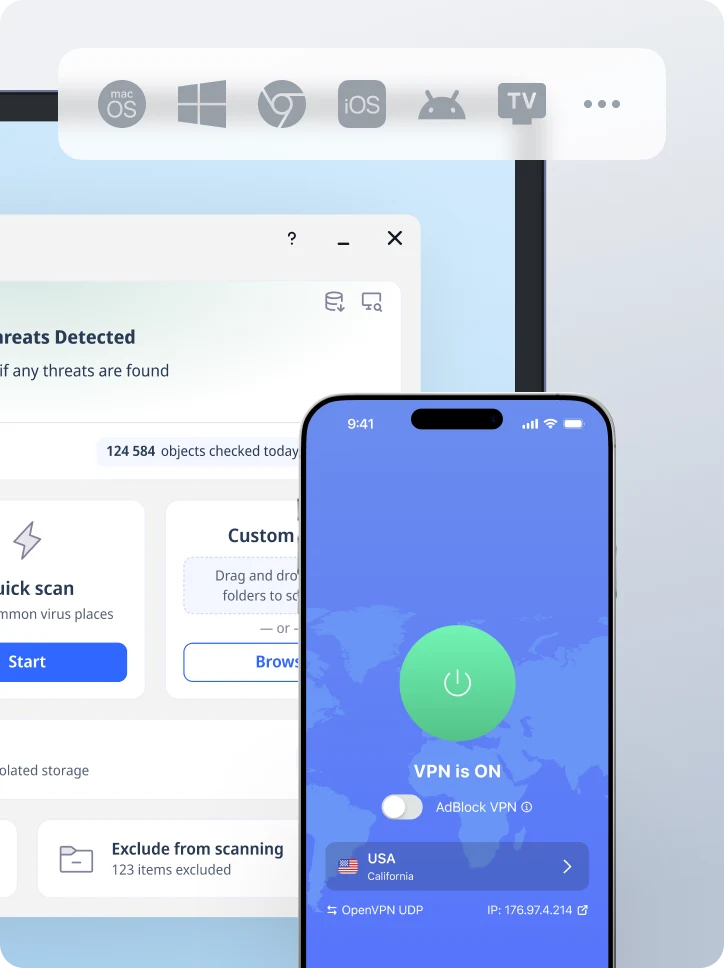Svchost: Hands-on Guide to Windows’ Service Host (And How to Keep it in Check)
Fire up “Task Manager” on any Windows PC and you will notice a forest of svchost.exe entries. Some sit idle, others gulp CPU, and a few spike your fans the moment the network cable plugs in. It is perfectly normal to see these service host processes, because Windows cannot boot without them. But the open design that makes them flexible also leaves the door cracked for malware impersonation and runaway resource use.
This guide breaks down what svchost.exe actually does, why you see multiple instances, and how to fix, verify, or shut down misbehaving copies without crippling the operating system. You will also learn how VeePN’s security toolkit keeps rogue background services away.

What is svchost and why does Windows need it?
A quick bridge before we dive into tweaks.
Svchost (short for “service host”) is a shared service process that loads dynamic link libraries (DLL files) instead of stand-alone executables. Each DLL contains a small Windows service (anything from print spoolers to network services). Grouping them under a single parent saves system resources and simplifies patching.
Microsoft introduced the model back in Windows 2000, then doubled down in Windows 10 and Windows Server to boost startup times. Without it, your boot sequence would juggle dozens of mini-apps rather than a handful of containers.
Why you see multiple svchost entries in task manager
The next question is obvious: if svchost.exe is one program, why do twelve of them glare at you in Task Manager?
Service grouping for stability
Windows clusters related services—for example, DNS cache, DHCP client, and TCP/IP helper into one svchost. Crash one, and the rest of your desktop survives. Splitting critical and optional components also guards against full system instability.
Per-service security isolation
Since Windows 10 1703, low-trust components like network discovery run in their own container. If a bad update breaks Wi-Fi, at least your desktop shell stays online.
Hardware-driven instances
On laptops, power management spawns a dedicated svchost to conserve memory and processing power. Plug in a virtual machine and you will trigger yet another instance for Hyper-V.
That design is great when everything works, but it also means spotting malicious copies takes detective work.
Investigating svchost safely inside task manager
A short paragraph to connect the dots. Before you hit the “End Task,” you need proof the process is guilty. These steps help you confirm this “.exe” is the real deal.
Check the file location and file path
- Open “Task Manager”
- Right-click the suspect “svchost”
- Choose “Open file location”
A genuine copy lives in C:\Windows\System32\svchost.exe.
Anything parked in Temp, AppData, or an odd file path should raise alarms. MITRE calls this “task or service masquerading,” which is an attacker tactic flagged in technique T1036.004.
Use command prompt for service details
- Press “Win + R” combination
- Type “cmd”
- Press “Enter”
- Run tasklist /svc /fi “imagename eq svchost.exe”
to map each PID to its specific service.
Compare the list with Microsoft’s official database. Unknown labels are prime malware candidates.
Scan with trusted Antivirus software
Even legitimate-looking copies can be patched in memory. A quick scan with Windows Security or a third-party antivirus digs deeper than hash checks. If you use VeePN’s Netguard (explained later), it blocks the command-and-control servers before the payload lands.
Warning signs svchost is hiding malware
It helps to pin real red flags to everyday behavior. Keep an eye on these tell-tale clues, each backed by an easy-to-check argument:
Unknown file location
As we already said before, if the path is anywhere but C:\Windows\System32 (or SysWOW64 on 64-bit PCs), you are likely dealing with an impostor.
Digital signature mismatch
Legitimate svchost.exe is signed by Microsoft. In the Details tab, check “Digital Signatures.” Anything unsigned or signed by an unknown vendor is a giveaway.
Sudden CPU or memory spikes while idle
A healthy service host process rarely hogs resources for more than a few seconds. Constant 40-100 % load, especially tied to wuauserv or netsvcs, can signal a hijack or a botched update loop. Malware cleaning guides list endless svchost churn as a classic symptom because miners and spam bots need raw processing power to profit.
Unexplained outbound network traffic
Fire up Resource Monitor or “netstat -ano”. If svchost keeps chatting with IPs in far-flung countries, something is wrong: core Windows services rarely maintain dozens of external sockets.
Disabled or missing security services
Malware that hijacks svchost often kills Windows Defender, automatic updates, or the firewall to stay hidden. If those services refuse to start or vanish from the “services.msc” list, investigate the parent process chain immediately.
The process respawns after “select end task”
When you right-click and “End task”, legitimate services restart once or twice under the Service Control Manager. An endless respawn loop (same PID range, same high load) points to a malicious watchdog rebuilding its foothold. That self-healing trait is common in coin-mining botnets that pose as service host processes.
Notice one or more of these signs? Disconnect from the network, run a full scan with trusted Antivirus software, and lock outbound traffic with a VPN or firewall until you are certain the exe file is clean.
Quick fixes for high svchost CPU or memory
Once you confirm the copy is legitimate, resource spikes usually trace back to a single misconfigured service.
Disable a specific service (temporary test)
- Type “services.msc” in Run
- Find the culprit
- Right-click it and choose “Stop”
- Observe CPU usage for a few minutes. If everything calms down, set the startup type to Manual until you patch or reinstall the related programs.
- Never disable RpcSs or DcomLaunch – Windows will refuse to boot.
Reset Windows update components
- Open Command Prompt as admin.
- Run “net stop wuauserv” and “net stop bits”
- Delete the SoftwareDistribution folder, then restart the services.
- Reboot and check if the rogue service host cools off.
Repair system files
Running “sfc /scannow” followed by “DISM /Online /Cleanup-Image /RestoreHealth” replaces corrupted dll files that might loop inside a stuck svchost.
How a VPN shuts the door on rogue service hosts
Even a patched PC is vulnerable if a malicious svchost sneaks past and phones home. Encrypting every packet with a VPN blocks that outbound beacon and hides what software you run from curious ISPs.
VeePN advanced features that keep svchost honest
Below is what VeePN brings to the table:
Block threats before they load
NetGuard pre-filters DNS requests and drops known malware domains, phishing pages, and ad trackers. That means a fake svchost.exe never receives its command script, and your browser loads faster without the ad bloat.
Built-in Antivirus
The built-in Antivirus engine of VeePN scans downloaded files, running applications and processes in real time. It scans and prevents viruses, trojans and spyware including that which poses as a genuine service such as svchost.exe before it can damage your computer or steal your information.
Breach Alert
VeePN continuously scans dark-web dumps for your email or password. If a leak includes your address, you receive an instant heads-up, which is especially critical if malware lurking in svchost already scraped your credentials.
Military-grade encryption
The service wraps every bit in AES-256 encryption, locking snoops out of keystrokes and blocking packet inspection tools that hunt for unencrypted Windows telemetry.
Kill Switch protection
Should the VPN link drop, Kill Switch slams the brakes on all traffic. A rogue exe file cannot sneak out a log while your Wi-Fi flips networks.
Strict No Logs policy
VeePN records zero data about sites you visit or programs you run, so spyware posing as Windows processes cannot subpoena a footprint that does not exist.
10-device support
One subscription blankets your laptop, phone, and even that dusty desktop your kids still use—closing the weakest link attackers love.
Try VeePN without risks with our 30-day money-back guarantee.
FAQ
- Open “Task Manager”
- Right-click the suspicious entry
- Hit “Open file location”
Anything outside System32 is shady. Cross-check with “tasklist /svc” and run a full scan with a trusted antivirus.
The master process is mandatory, but you can stop a specific service inside it. Always test by stopping the service in services.msc rather than killing the parent, or you might crash Windows.
Windows splits multiple services into separate containers for security. Each group handles related tasks, so one crash does not wipe the whole OS.
Usually a single runaway service—Windows Update, Superfetch, or a hidden miner—is stuck in a loop. Identify the PID, check its associated service, and either restart it or patch the offending software.
VeePN is freedom
Download VeePN Client for All Platforms
Enjoy a smooth VPN experience anywhere, anytime. No matter the device you have — phone or laptop, tablet or router — VeePN’s next-gen data protection and ultra-fast speeds will cover all of them.
Download for PC Download for Mac IOS and Android App
IOS and Android App
Want secure browsing while reading this?
See the difference for yourself - Try VeePN PRO for 3-days for $1, no risk, no pressure.
Start My $1 TrialThen VeePN PRO 1-year plan








